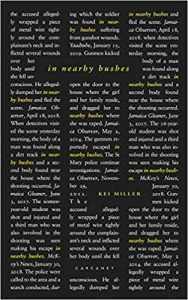Not as many as you’d think, but some of the books I’ve been reading have been fabulous. One trend I’ve noticed however – the number of men who are writing about herbs! I’m sure when Haggards came out it was mostly women who liked the herb poems, but lately things seem to be a bit different. I’ll get to Seán Hewitt later, and in another context, but for now, lets look at Kei Miller’s In Nearby Bushes.

‘Nearby bushes’ in Jamaica are not merely undergrowth or shrubbery. They are the equivalent of ‘the forest’ of medieval outlaws, ‘the bush’ in Australia, the back streets of urban estates, the closes of older Edinburgh, the ‘no go’ areas of countries in a state of civil unrest. It was tempting to draw a parallel with my ‘haggards’, especially as Kei Miller discusses issues around forced exile, colonialism, and suppression of indigenous knowledge (including herbal medicine), but as we will see, ‘nearby bushes’ are a darker place. Whereas my haggards and maquis are places of neglect, exile and abandonment, but also sources of resistance and revitalisation, ‘nearby bushes’ are an insight into the ‘shadow’ (in a Jungian sense), of Jamaican culture.
It is the essence of the shadow that it should not be known and understood in itself, but should be spoken of only in line with the expectations of the dominant mindset, and in the second section Sometimes I Consider the Names of Places, Kei Miller draws attention to this – all the colours have been subsumed under ‘green’ in To Know Green from Green, all the islands are ‘Indio’ in Sometimes I Consider the Names of Places (3):
We are insufficiently imagined people from an insufficiently
imagined place
and the magnificent Place Name: Oracabesa, which points out that the whole country is being assessed solely in terms of the gold which colonialists expected to find there. What we know of a place or a people is limited by the limitations we create in our language.
In Scotland, where the history of erasure and exile in the Highlands was suppressed until recently, while at the same time, Scottish people enacted the very same oppression elsewhere in the name of the British Empire, it relevant that Miller also discusses how Jamaicans themselves align themselves with the dominant colonial culture, denying their history, forgetting their own local knowledge and stories, abandoning local dialects to speak with ‘sweet yankee accents’ or aspiring to own a BMW X5 (VII:II). It is important for Jamaicans to be aware of the stubborn survival of native folk tales and urban myths amid
de heap
of bruk bokkle & de plenty bun up cyar
and the mint, pawpaw sage and ginger, the poisonous or healing plants that grandmothers know.
they are here – in the complications of roots, in the dirtiness
of dirt.
And not only survival, but development. Here Where Run the Wild Deer deals with the importation and escape into the wild of six reindeer, which behave like the invasive species we deplore here, but in this poem serve as a parable of adaptation and inclusion ‘how to belong/where we do not belong’.
But he also points out that the shadow is a place of denial and scapegoating, where a people may indiscriminately locate things they don’t want to accept, like poverty, shame, homosexuality, crime, violence. It is a place of judgement, where to be found is to be made a criminal or a corpse and all sense of individual identity is lost. The book opens with a memorial list of ‘only some’ of those found dead there and the last section, In Nearby Bushes, is a meditation on the death of a young woman, who becomes again a real individual person – ‘in the dream you are my cousin’, whose death is mourned, and whose life is given the value and dignity the nearby bushes have denied her.
This is a dark book, with dark themes, but it is not heavy. There is a lightness, a conversational tone ‘I mean the flowers —- I no longer mean the flowers’ (Here Where Blossoms the Night) which belies the complexity of the subject and a great attention to the skills of story-tellers. The rhythms are crafted for careful reading aloud, with beautiful cadences which remind me of the King James translation (or in my case the Douai) of the Bible, though there are no explicit verbal echoes. Although 2020 has been a fabulous year for new poetry (Moya Campbell, Alice Oswald, Natalie Diaz and Seán Hewitt, so far, and it’s only August), I think this might be the outstanding book of the year, for me.
In Nearby Bushes
Kei Miller
Carcanet 978 1 78410 845 8
Leave a Reply